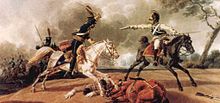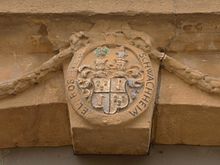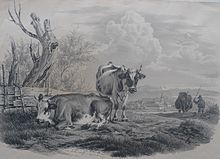Samuel Abraham von Renner
Samuel Abraham Renner (* 1. December 1776 in Bad Schinznach , Unteraargau ; † 4. July 1850 in Bad Mergentheim , Württemberg ) was a in Bavaria active Swiss -württembergischer agricultural reformer .
Life
Imperial-royal cavalry officer

His parents were Johann Anton Renner (1743–1800) from Nidau in the canton of Bern and his wife Henriette, née von Schwachheim (1746 - 1802 at the latest). The father owned Bad Schinznach at the foot of the Habsburgs , which Renner's grandfather Franz Daniel Freiherr von Schwachheim (1708 - 1794 at the earliest) had given him. Thanks to the protection of his uncle General Sigmund Freiherr von Renner (1727–1800), the 16-year-old Samuel Abraham became an ensign in the Imperial-Royal Karabiniers in the First Coalition War . Relocated to the front on the Rhine, he was a first lieutenant a year later . He also took part in the Second Coalition War . He became a captain with the cuirassiers , then with the hussars . Main heir of the aforementioned uncle, he retired as a major at the age of 26 and married a cousin, the pharmacist's daughter Friederike Mörike (1780–1850) from Neuenstadt am Kocher (Württemberg). He had thirteen wounds left, including a broken jaw.
From Württemberg to Bavaria
As a friend of the expropriated Prince Karl Albrecht III. To Hohenlohe-Waldenburg-Schillingsfürst , Renner acquired the former Hohenlohe domain of Hohebuch near Waldenburg (Württemberg) in 1808 . 1815-1817 he represented the Oberamt Öhringen ( Jagstkreis ) in the state estates of the kingdom. In 1817 his cousin Hieronymus von Meyer brought him to Bavaria, where his uncle Colonel Friedrich Freiherr von Schwachheim (1752–1828), retired director of the military academy in Munich and brother of the Bavarian diplomat Franz Rudolf Freiherr von Schwachheim (1731–1804), lived. Meyer sold him the Polling monastery in the so-called Pfaffenwinkel . To be able to acquire it, Renner had to take out a large loan from a Basel bank and commit to paying Meyer an annuity . He kept Hohebuch for the time being. In 1819 he ran again for the Württemberg state parliament, but became a target of the liberals and did not make the election.
"Model economy for this area"
As a result, Renner made Polling an agricultural research institute. In 1821 Heinrich von Nagel reported on a visit to the “great economist” in Polling: “How amazed I was, since I have seen many dairy farms and sweat shops in my life when I met the most beautiful, healthiest cattle here.” The cows are from Canton Uri and would give 23 to 27 liters of milk a day. This value is above today's milk production in Germany. As Nagel further wrote, Renner's cows were "as neatly cleaned as a horse that is being harnessed to a mansion's carriage". The Swiss took care of the maintenance of the animals, the milking and the cheese-making . At the Oktoberfest in 1822 Renner had the most beautiful bull and the most beautiful cow in Bavaria and was awarded a double silver medal, because he had transformed Polling "through immense effort and activity into a model farm for the region". In 1824 he received an East Frisian bull and Chinese pigs from King Wilhelm von Württemberg .
Bricks for the Alte Pinakothek
Since high investments were offset by low prices for agricultural products, Renner had to borrow more money despite high production, namely from Augsburg philanthropist Johann Lorenz Freiherr von Schaezler . He also modernized the brickworks of the former monastery and supplied the bricks for the exposed masonry of the Alte Pinakothek in Munich, which was built between 1826 and 1836 . In 1827/28 he received an interest-free loan from the state to expand the brickworks. In 1829 he was elected to the district administrator of the Isar district, but was no longer allowed to run as a foreigner in 1831. At that time, the Bavarian State Ministry of the Interior recommended his clay water pipes to the district governments. In 1832 he applied unsuccessfully for the position of director of the Hohenheim Agricultural College near Stuttgart .
Old age at Eduard Mörike's side
In 1837 Renner could no longer meet his financial obligations, whereupon his creditors appointed Hieronymus von Meyer as bankruptcy administrator . Nonetheless, Renner received the large gold medal at the Oktoberfest in 1838 "for the introduction of improved agricultural implements, appropriate preparation of fertilizer, increase in forage and livestock to 200 pieces, large offspring of 104 pieces in 2 years". Ludwig Fürst von Oettingen-Wallerstein wrote in 1841 that Renner had developed the Swiss cattle introduced by Hieronymus von Meyer through crossbreeding "into a peculiar Raçe of eminent size, strength, agility, meat quality, fattening ability and milk production" and "raised the livestock of the whole area" . In 1843 Renner's main creditor at the time took over Polling. The Prince of Oettingen-Wallerstein then leased the Kirchheim am Ries monastery in Württemberg to the major . But in 1846 Renner was again insolvent . He and his wife spent their twilight years in Bad Mergentheim at the side of their relative, the poet Eduard Mörike (1804–1875). Their only surviving children, Albrecht (1805–1879) and Karl (1815–1873), were deaf and mute and remained unmarried.
literature
- Frank Raberg : Biographical handbook of the Württemberg state parliament members 1815-1933 . On behalf of the Commission for Historical Regional Studies in Baden-Württemberg. Kohlhammer, Stuttgart 2001, ISBN 3-17-016604-2 , p. 714 .
- Peter Genner: The hosts of the Helvetic Society. The Schwachheim-Renner family as the owners of Bad Schinznach and their emigration to Bavaria. In: Argovia, 124/2012, pp. 126-179 ( digitized version ).
- Peter Genner: After the rule of the monastery - Swiss revolutionaries in the Pfaffenwinkel. In: Der Welf, yearbook of the historical association Schongau, 2013, pp. 69–192 ( digitized version ), with family tree.
References and comments
- ↑ The nobility Renner put to himself. In 1818 and again in 1834–1836 he tried to be enrolled in Württemberg as a descendant of the noble Renner von Allmendingen , which he did not succeed.
- ↑ Son of the imperial-royal resident in Basel, secret registrar in the Bavarian Ministry of Finance and secretary of the general committee of the Agricultural Association in Bavaria.
- ↑ 20 to 25 mass.
- ↑ 18 to 25 kg per day (Federal Ministry of Food, Agriculture and Consumer Protection: Die deutsche Landwirtschaft, performance in data and facts. 2010 edition, p. 14.)
- ↑ About pasture and stable feeding. In: Weekly newspaper of the agricultural association in Baiern, July 23, 1822, columns 658–661, here: p. 660 f. Compare travel epistle through the Isar district, by Baron von Hallberg . Augsburg 1822, p. 108 f.
- ↑ Weekly paper of the agricultural association in Baiern, October 29, 1822, supplement, columns 72, 81 f., Quote: column 81.
- ↑ Centralblatt des Agricultural Association in Bavaria, 1838, supplement, p. 3.
- ↑ Lecture on the improvement of horned cattle breeding, ibid., 1841, pp. 114–143 (Appendix 3), quotation: p. 125 / note. 24.
- ↑ The guarantor was, among others, the later Chancellor Chlodwig Fürst zu Hohenlohe-Schillingsfürst , whose father had once borrowed money from Renner.
| personal data | |
|---|---|
| SURNAME | Renner, Samuel Abraham from |
| BRIEF DESCRIPTION | Swiss-Württemberg agricultural reformer in Bavaria |
| DATE OF BIRTH | December 1, 1776 |
| PLACE OF BIRTH | Bad Schinznach , Bernese Aargau : |
| DATE OF DEATH | 4th July 1850 |
| Place of death | Mergentheim , Württemberg |


